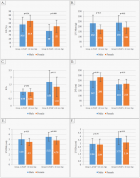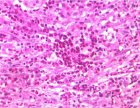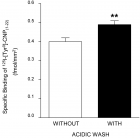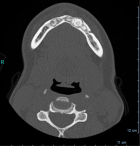Abstract
Case Report
Evolution of anaesthesia in transapical aortic valve implantation Running head: Anaesthesia and transcatheter valve
Marzia Cottini*, Lappa A, Donfrancesco S and Francesco Musumeci
Published: 20 September, 2017 | Volume 1 - Issue 1 | Pages: 020-023
The Transcatheter Aortic Valve Implantation (TAVI) had emerged more and more in the last twenty years. According to the scientific literature, this is an approved, suitable and alternative therapeutic choice to conventional surgery for aortic valve disease in high risk patients. The most of patients are octogenarians or nonagenarians, with multiple comorbidities (neurological,vascular,oncologic, haematological, etc). The evolution of TAVI techniques and its devices have improved the quality of results and reduced the peri- and post-procedural complications. Cardiac anaesthesia and analgesia in TAVI patients is very important and fundamental to a quickly and complete clinical restoring after the procedure. An optimal balance of drugs and peri-procedural management could reduce the neurological events (such as delirium), the days of hospitalization and the admission of intensive care unit. According to our experience in transapical approach, the low dose of propofol and desflurane allowed to optimal cardiac anaesthesia and rapid mechanical ventilation weaning in complex patient undergone to transcatheter valve implantation with transapical approach. Moreover, our protocol reduced considerably the incidence of perioperative delirium.
Read Full Article HTML DOI: 10.29328/journal.hacr.1001003 Cite this Article Read Full Article PDF
Keywords:
Valve replacement; Transapical valve; Anaesthesia; Octogenarians
References
- Biancari F, D'Errigo P, Rosato S, Pol M, Tamburino C, et al. Transcatheter aortic valve replacement in nonagenarians: early and intermediate outcome from the OBSERVANT study and meta-analysis of the literature. Heart Vessels. 2017; 32: 157-165. Ref.: https://goo.gl/jKHnDP
- Stanska A, Jagielak D, Brzezinski M, Zembala M, Wojakowski W, et al. Improvement of quality of life following transcatheter aortic valve implantation in the elderly: A multi-centre study based on the Polish national TAVI registry. Kardiol Pol. 2017; 75: 13-20. Ref.: https://goo.gl/UgGSNE
- Antinori A, Arendt G, Becker JT. HHS Public Access. 2015; 69: 1789-1799.
- Vahanian A, Urena M, Walther T, Treede H, Wendler O, et al. EuroIntervention Thirty-day outcomes in patients at intermediate risk for surgery from the SAPIEN 3 European approval trial. EuroIntervention. 2017; 12: 235-243. Ref.: https://goo.gl/UC19vb
- Huang PH, Eisenhauer AC. Transcatheter aortic valve replacement using the Edwards SAPIEN transcatheter heart valves. Cardiol Clin. 2013; 31: 337-350. Ref.: https://goo.gl/QUMyWm
- Varghese V, George JC. Evolution in transcatheter aortic valve replacement: The Core Valve? self-expanding prosthetic aortic valve. Interv Cardiol. 2012. Ref.: https://goo.gl/wW1kh4
Figures:

Figure 1

Figure 2
Similar Articles
-
Submitral Ventricular Pseudoaneurysm: Unusual and Late Complication of Cardiac SurgeryMarzia Cottini*,Amedeo Pergolini,Giordano Zampi,Vitaliano Buffa,Paolo Giuseppe Pino,Federico Ranocchi,Riccardo Gherli,De Marco Marina,Carlo Contento,Myriam Lo Presti,Francesco Musumeci. Submitral Ventricular Pseudoaneurysm: Unusual and Late Complication of Cardiac Surgery . . 2017 doi: 10.29328/journal.hacr.1001001; 1: 001-004
-
Evolution of anaesthesia in transapical aortic valve implantation Running head: Anaesthesia and transcatheter valveMarzia Cottini*, Lappa A,Donfrancesco S,Francesco Musumeci. Evolution of anaesthesia in transapical aortic valve implantation Running head: Anaesthesia and transcatheter valve . . 2017 doi: 10.29328/journal.hacr.1001003; 1: 020-023
-
Blockade of the distal sciatic nerve with the patient in the supine position using a newly developed position aid with integrated ultrasound probe holderMichael Schütz*,Jens Magunia,Hans-Bernd Hopf. Blockade of the distal sciatic nerve with the patient in the supine position using a newly developed position aid with integrated ultrasound probe holder. . 2019 doi: 10.29328/journal.ijcar.1001012; 3: 003-006
-
Anaesthetic management of an elderly patient with ischaemic heart disease and previous MI undergoing elective inguinal hernia repair: Case reportKhaleel Ahmad Najar(Senior Resident)*,Anka Amin(Assistant Professor),Mohammad Ommid(Associate Professor). Anaesthetic management of an elderly patient with ischaemic heart disease and previous MI undergoing elective inguinal hernia repair: Case report. . 2020 doi: 10.29328/journal.ijcar.1001013; 4: 001-003
-
A witnessed intra-operative blood transfusion-related air embolism under epidural anaesthesia for vesicovaginal fistula repairGyadale AN*,Adeyanju BT,Ayegbusi EO,Adeyiolu AT,Olabode AA,Suberu SO,Olajide MA. A witnessed intra-operative blood transfusion-related air embolism under epidural anaesthesia for vesicovaginal fistula repair. . 2022 doi: 10.29328/journal.ijcar.1001018; 6: 001-003
-
Minimising Carbon Footprint in Anaesthesia PracticeNisha Gandhi and Abinav Sarvesh SPS*. Minimising Carbon Footprint in Anaesthesia Practice. . 2024 doi: 10.29328/journal.ijcar.1001025; 8: 005-007
-
Comparison of Effect of Intrathecal Fentanyl 25µg with 0.5% Hyperbaric Bupivacaine and Only 0.5% Hyperbaric BupivacaineParveen Gafla*. Comparison of Effect of Intrathecal Fentanyl 25µg with 0.5% Hyperbaric Bupivacaine and Only 0.5% Hyperbaric Bupivacaine. . 2025 doi: 10.29328/journal.ijcar.1001029; 9: 017-022
Recently Viewed
-
Molecular profiles of hepatotoxicity and nephrotoxicity markers in dysmenorrheic (on treatment or not) studentsOngbayokolak N Sylvie,Djeudong Geraldo,Bilim B Joseph,Telefo Phelix Bruno*. Molecular profiles of hepatotoxicity and nephrotoxicity markers in dysmenorrheic (on treatment or not) students. Clin J Obstet Gynecol. 2020: doi: 10.29328/journal.cjog.1001042; 3: 013-017
-
Fetal Alcohol Spectrum Disorders – What does it mean?Rajeev Gupta*. Fetal Alcohol Spectrum Disorders – What does it mean?. Clin J Obstet Gynecol. 2020: doi: 10.29328/journal.cjog.1001043; 3: 018-020
-
Systemic Lupus Erythematosus and Depression OverviewAhmed Shaaban*,Nourelhouda Said,Hoda Afifi. Systemic Lupus Erythematosus and Depression Overview. Insights Depress Anxiety. 2024: doi: 10.29328/journal.ida.1001039; 8: 001-004
-
Intelligent Design of Ecological Furniture in Risk Areas based on Artificial SimulationTorres del Salto Rommy Adelfa*, Bryan Alfonso Colorado Pástor*. Intelligent Design of Ecological Furniture in Risk Areas based on Artificial Simulation. Arch Surg Clin Res. 2024: doi: 10.29328/journal.ascr.1001083; 8: 062-068
-
Pancreatico-gastric FistulaRony Varghese*, Amal Upadhyay, Pawan Kumar Jaiprakah Maniyar. Pancreatico-gastric Fistula. J Clin Med Exp Images. 2024: doi: 10.29328/journal.jcmei.1001030; 8: 001-002
Most Viewed
-
Evaluation of Biostimulants Based on Recovered Protein Hydrolysates from Animal By-products as Plant Growth EnhancersH Pérez-Aguilar*, M Lacruz-Asaro, F Arán-Ais. Evaluation of Biostimulants Based on Recovered Protein Hydrolysates from Animal By-products as Plant Growth Enhancers. J Plant Sci Phytopathol. 2023 doi: 10.29328/journal.jpsp.1001104; 7: 042-047
-
Sinonasal Myxoma Extending into the Orbit in a 4-Year Old: A Case PresentationJulian A Purrinos*, Ramzi Younis. Sinonasal Myxoma Extending into the Orbit in a 4-Year Old: A Case Presentation. Arch Case Rep. 2024 doi: 10.29328/journal.acr.1001099; 8: 075-077
-
Feasibility study of magnetic sensing for detecting single-neuron action potentialsDenis Tonini,Kai Wu,Renata Saha,Jian-Ping Wang*. Feasibility study of magnetic sensing for detecting single-neuron action potentials. Ann Biomed Sci Eng. 2022 doi: 10.29328/journal.abse.1001018; 6: 019-029
-
Pediatric Dysgerminoma: Unveiling a Rare Ovarian TumorFaten Limaiem*, Khalil Saffar, Ahmed Halouani. Pediatric Dysgerminoma: Unveiling a Rare Ovarian Tumor. Arch Case Rep. 2024 doi: 10.29328/journal.acr.1001087; 8: 010-013
-
Physical activity can change the physiological and psychological circumstances during COVID-19 pandemic: A narrative reviewKhashayar Maroufi*. Physical activity can change the physiological and psychological circumstances during COVID-19 pandemic: A narrative review. J Sports Med Ther. 2021 doi: 10.29328/journal.jsmt.1001051; 6: 001-007

HSPI: We're glad you're here. Please click "create a new Query" if you are a new visitor to our website and need further information from us.
If you are already a member of our network and need to keep track of any developments regarding a question you have already submitted, click "take me to my Query."

















































































































































